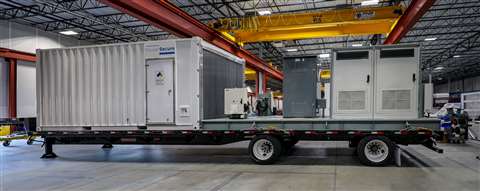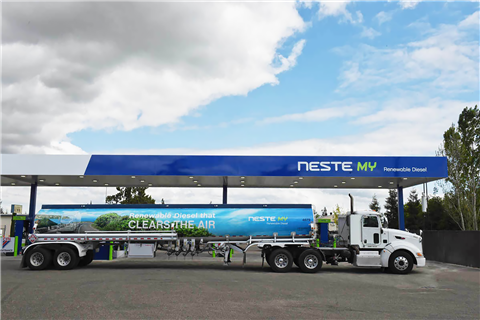How PowerSecure developed a battery charging system for mass transit
08 February 2022
PowerSecure develops mobile battery charging system for mass transit fleet.
 Chatham Area Transit’s new electric bus mobile charger incorporates a 20 ft. PowerBlock container from PowerSecure and a 40 ft. trailer built specifically for the application. (Photo: PowerSecure)
Chatham Area Transit’s new electric bus mobile charger incorporates a 20 ft. PowerBlock container from PowerSecure and a 40 ft. trailer built specifically for the application. (Photo: PowerSecure)
While Hurricane Dorian twisted its way toward Savannah, Ga., in September 2019, the city’s Chatham Area Transit Authority (CAT) switched into emergency mode. With Chatham County under mandatory evacuation, the bus company waived its fares for residents without private vehicles. Riders were transported from bus stops throughout the region to the civic center, after which charter buses carried them to shelters well off the coast. The county was ultimately spared from severe destruction, and a few days later CAT was returned to its regular paying routes.
The potential for future storms was top of mind as the transit agency worked to add battery electric buses to its fleet. Range anxiety became a very real thing as the team considered how to keep its electric buses on the job during emergency evacuations as well non-traditional routes during positive community events like festivals.
FTA awards CAT a $1.87 million grant
In May 2020, the Federal Transit Administration (FTA) awarded CAT a $1.87 million grant for the purchase of three Gillig electric buses, six charging stations, infrastructure upgrades and – to help ease the anxiety — a purpose-built mobile generator and charging unit. Funding via FTA’s Low or No Emission Vehicle Program grant helped the transit agency replace aging diesel buses with electric vehicles. Earlier funding had already helped the group purchase six electric buses.
CAT enlisted the assistance of the Utility Services business of its local utility, Georgia Power, for electrical infrastructure upgrades at its bus depot while PowerSecure, a provider of distributed energy solutions, developed and provided the mobile bus charging unit. PowerSecure and Georgia Power are subsidiaries of Southern Company, a gas and electric utility holding company based in Atlanta.
“This project is a testament to Southern Company’s continued investment in building the future of energy,” said Eric Dupont, chief commercial officer at PowerSecure, Durham, N.C. “This was a great collaborative effort between Georgia Power and PowerSecure teams to deliver this customized solution and provide significant value to CAT, which serves the heart of the greater Savannah community, with a sustainable solution for the ‘electrification of everything.’ This turnkey program provides clean and reliable transportation to nearly 4 million passengers annually.”
Georgia Power Utility Services
Georgia Power Utility Services’ Cliff Buckalew was the project manager for the transit agency job. “CAT’s coverage area is mostly all a downtown-type of route system, and they’ve got a centralized location in downtown Savannah that’s a few blocks from the Savannah River, which is susceptible to hurricane flooding. Part of CAT’s emergency planning strategy was when storms came, they wanted to get their buses out of Savannah and take the charging platform with them.”
The transit agency looked to Georgia Power to build an infrastructure system that would charge buses while parked at the depot but can also hit the road when necessary. The mobile unit can charge four buses at a time, anywhere.
“CAT uses the mobile charger inside its home depot to charge buses every night. In normal circumstances they run it off utility power and don’t run the diesel generator,” said Buckalew. “In that way, the system gets used every day. When an emergency comes, they can unhook it from the utility, hook it up to a truck, and haul out of there.”
“It’s really a unique concept,” said Michaell Bever, utility sales director for PowerSecure. “CAT didn’t want to waste the money to have a bunch of bus chargers committed to this mobile unit, so we put a transfer scheme on it so the mobile unit can be backed into a spot in the bus yard and act as a permanent onsite charger along with the other permanent infrastructure. Now that asset doesn’t have to be stranded waiting for mobile use. PowerSecure designed the transfer scheme for the unit, addressing some code issues and safety concerns to make sure that interlock was safe.”
The Savannah project
The Savannah project was fast-tracked and completed within a few months during 2020. The mobile unit is based on PowerSecure’s PowerBlock Mobile (PBM) power generation system, which are enclosed with purpose-built ISO shipping containers.
CAT’s mobile charger incorporates a 20 ft. PowerBlock container and a 40 ft. trailer built specifically for the application. When charging batteries in locations beyond the bus yard, the unit is powered by a factory certified Tier 4 final diesel engine — a 625 kW 16 L Volvo Penta TWD1673GE – to energize ABB battery chargers mounted to the 20 ft. deck of the trailer.
“From an engine perspective,” said Buckalew, “the Volvo Penta technology was the perfect fit for this mobile charging platform especially because the compact package fits nicely is what essentially looks like an 18-wheeler trailer.”
The onboard diesel fuel tank was sized for a 48-hour run time and special storage was designed to help keep charging cables organized and safe.
“Georgia Power, Southern Company and PowerSecure formed a unique team,” said Buckalew. “We know the utility side and the customer side of the business and PowerSecure knows diesel generation systems, so we could provide the customer a one-stop solution. That’s what CAT liked,” said Buckalew,
At the bus depot, Kirk interlocks are used to protect a portable cable between utility power and trailer into the utility side of PowerSecure switch gear. An onboard transfer system allows the system to power the ABB battery chargers while on utility power. CAT currently charges four buses through the mobile unit with two additional buses charged via permanently mounted ABB chargers connected to the utility. The charging systems can be expanded as the fleet grows.
When it comes time for off-site deployment during an emergency or an event, shore power is disconnected, and the transfer scheme switches over to permit the diesel generator to power the charging system.
“Lots of people build mobile generators and some have built mobile bus chargers, but this is unique,” said Bever. “It’s a self-contained unit that can run remotely on its own diesel fuel, and, and then also run off of normal power through camlock portable cables.”
While the CAT solution was developed for a specific use case, Buckalew and Bever both said the mobile electric vehicle charging system concept could be easily replicated for a wide range of electric vehicle fleets.
PowerSecure PowerBlock: ready for renewable fuelPowerSecure said its PowerBlock generation solutions are fully compatible with renewable diesel and renewable natural gas (RNG). “The transition to renewable fuel helps organizations achieve multiple goals: protecting investments and assets from being stranded as technology evolves, decarbonizing operations and maintaining critical operations during grid outages,” said Eric Dupont, chief development officer of PowerSecure, Durham, N.C. “Renewable fuels not only have the potential to displace an enormous amount of carbon emissions, but they represent a major milestone for PowerSecure and the energy users and producers we serve towards being future-ready.” PowerSecure formed a strategic collaboration with Finland-based Neste Oyj, a producer of renewable diesel and natural gas, to offer its customers a choice of fuel.  PowerSecure and Neste have worked together to ensure it the former’s PowerBlock generation solutions are fully compatible with renewable diesel and renewable natural gas (RNG), including Neste MY renewable diesel. (Photo: Neste) PowerSecure and Neste have worked together to ensure it the former’s PowerBlock generation solutions are fully compatible with renewable diesel and renewable natural gas (RNG), including Neste MY renewable diesel. (Photo: Neste)
Renewable diesel and RNG are produced by recycling carbon in the atmosphere. Renewable diesel, which is reportedly made from 100% renewable raw materials, contains no aromatics, emits no new engine-out greenhouse gases and significantly reduces fine particulates and nitrogen oxides. RNG is made from methane captured from biomass waste and produces on average 51% fewer greenhouse gas emissions that are reportedly 21 times less potent than if that methane was released directly into the atmosphere. PowerSecure said these “drop-in” fuels can be fully utilized in existing PowerBlock spark- and compression-ignition assets with no equipment modifications or additional costs required and help organizations transition away from fossil fuels while still realizing high performance and reliability. “We are always looking ahead and continuously improving our solutions to maximize value for our customers now and well into the future,” said Dupont. Neste supplies a growing volume of renewable diesel and sustainable aviation fuel in the United States and Europe. Last year, Neste MY renewable diesel received Top Tier Diesel Fuel certification for it quality and performance. The standard was introduced in 2017 and has been endorsed by engine manufacturers such as Detroit Diesel Corp., Navistar, General Motors and Ford. The fuel is currently available in the United States at more than 1400 delivery points in California and Oregon. Neste MY Renewable Diesel is available in Europe in Belgium, the Netherlands, Finland, Sweden, Estonia, Latvia and Lithuania. |
STAY CONNECTED




Receive the information you need when you need it through our world-leading magazines, newsletters and daily briefings.
POWER SOURCING GUIDE
The trusted reference and buyer’s guide for 83 years
The original “desktop search engine,” guiding nearly 10,000 users in more than 90 countries it is the primary reference for specifications and details on all the components that go into engine systems.
Visit Now
CONNECT WITH THE TEAM










